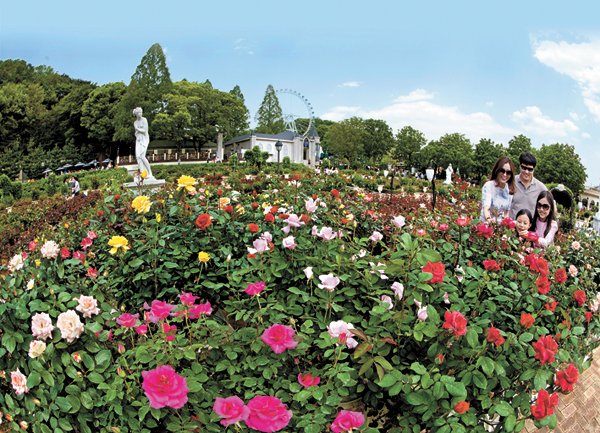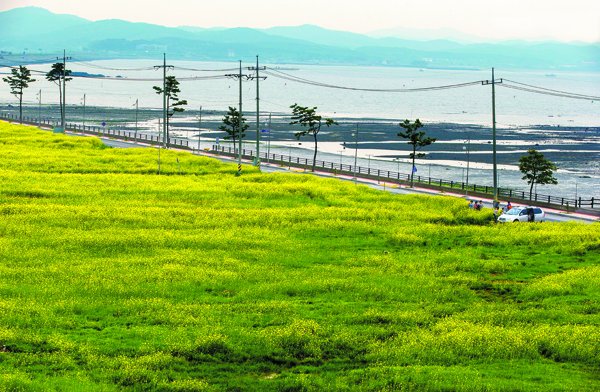Spend springtime hours in fields of flowers

Everland's Rose Festival, which is celebrating its 30th anniversary this year, will run until June 14. More than 670 species of roses are displayed at the park. By Ahn Sung-sik
Spring's cherry blossoms may have wilted, but other types of seasonal flowers are still at their peak across the peninsula, with stunning roses, irises, poppies, royal azaleas and rapeseed flowers blooming at this time of year.
But there are certain places where these beautiful blossoms congregate in large swathes, creating an incomparable sight.
Here's a guide on where to find them.
Rapeseed flowers on Ganwal Island
Ganwal Island, which is located on the southern edge of Seosan, South Chungcheong, has been gaining popularity for its rapeseed flowers, which the city planted at an unsold estate in September 2013.
Irises can be seen at Seoul Changpowon Park in Dobong, northeastern Seoul, from mid-May to early June. [JoongAng Ilbo]
At the locale there is a field, which is around 50,000 square meters (12.4 acres), filled with the yellow flowers.
Visitors can enjoy the spectacle in peace, plus a view of the coast, since hardly any cars pass by.
Ganwal Island is famous for its Ganwalam, a hermitage that can be reached at low tide that is blocked during the flowing tide. It is especially popular among photographers for its sunset view. Thousands of people visit on weekends and most stop by the rapeseed flowers, which will be available until mid-May, to take photos.
Don't want to leave Seoul? Guri Hangang River Citizen's Park boasts a rapeseed flower garden that is as large as 120,000 square meters. Or head to Hyeonchungsa Shrine in Asan, Chungcheong, to see a 30,000-square-meter area full of the blooms until they peak in mid-May.
Ganwal Island's rapeseed flower field can be found at the Ganwalam and Ganwal crossroads in Seosan, South Chungcheong. Parking spots are available when traveling by car. Bus Nos. 610 and 611 will take you from Seosan Bus Terminal to Ganwal Island.
Poppies are at the peak of their beauty at farmland belonging to Hankyung University in Anseong, Gyeonggi, from around May 20 to early June.[JoongAng Ilbo]
Call Seosan City Hall Culture and Tourism at (041) 660-2114 for more details.
Roses at Everland Resort
Everland in Yongin, Gyeonggi, is currently filled with a variety of roses. The Rose Festival, which marks its 30th anniversary this year, started on May 8 and will last until June 14. There is a reason for its long duration. Everland's 33,000-square-meter rosary has 670 species of rose. The blooming season of each type is different, so the festival lasts for a long time.
Everland plants 2,000 rose bushes every year.
"Roses that are more than 10 years old can't bloom properly. We make colorful spring scenery because we plant new roses every year", explained a person affiliated with Kim Chang-young's Park Landscape Gardening Center, a professional landscaping center that develops and manages rose species at Everland.
The company invests more than 200 million won ($182,315) annually in taking care of the roses, which are highly sensitive to cold weather. With its 30 years of experience, the company's rosary becomes more beautiful every year.
The peak season of the rose scenery will be from mid-May to early next month. Also, 1,200 large roses that are specially grown under glass are displayed.
There are various themes in Everland's rosary such as one section filled with 20,000 LED roses.
Everland will extend its opening hours until 10 p.m. for the festival. The LED rose garden is especially beautiful after the sunset. During the festival, there will be other events, including concerts and special parades. A one-day entry ticket is 40,000 won for adults and 31,000 for children. More information is available on everland.com or by telephone at (031) 320-5000.
Irises in Changpowon Park
Between Mount Dobong and Mount Surak in northeastern Seoul lies the botanical garden Seoul Changpowon. It is 52,000 square meters in size and has various plants, including herbs. The garden, however, is most notable for its springtime purple irises.
There is a rapeseed garden on Ganwal Island in Seosan, South Chungcheong. People can enjoy the beautiful flowers and the coastal scenery that can be seen from the garden.
The iris is a very rare flower species, but there are around 30,000 plants from more than 130 species, including iris setosa and bearded iris, in Seoul Changpowon. Inside, there is an iris garden measuring about 15,000 square meters, as well as a curved pond and several trails people can walk along while enjoying the scenery.
Irises in the botanical garden will bloom until early June.
"It will be a perfect season to enjoy the beauty of irises starting from mid-May. People can enjoy the flying spores of pasque flower around Seoul Changpowon", said Kim Hak-gu, who is responsible for the botanical garden.
A pedestrian overpass connects the Meeting Plaza near Mount Dobong subway station and Seoul Changpowon. Once people reach the top of the overpass, they can enjoy the whole view of the iris garden, which is magnificent.
Seoul Changpowon is located in Dobong District, northeastern Seoul. It is near Dobong Station exit No. 2. The botanical garden's opening hours are from 6 a.m. to 10 p.m. There is no entrance fee, and further information is available atparks.seoul.go.kr/irisgardenor by calling (02) 954-0031.
Poppies on Hankyung University's land
An abundance of brightly blooming poppies turns an entire hill in Yangbok-ri, Ansan, bright red during spring. It is located in a small village in between the rivers of Anseong and Kumgang.
Up until five years ago, the tourist attraction Floland - a combination of flower and land - could be found in the region. Although it enjoyed high popularity as a landscape with diverse flower species, including poppies and cornflowers, it is currently used as a research farm for Hankyung University.
Only poppies grow there now. But although it may not be as colorful as it used to be, it doesn't stop people with a fondness for flowers from visiting.
"The red hill gives a sense of a dreamlike and glamorous feeling", said a photographer who came to see the plants.
Although the trail is a little too short for a proper walk, there are other forms of entertainment for visitors to enjoy, such as resting at a pavilion or on the grass where children can freely run around.
Most of the visitors to the farmland are photographers who usually take photos at the foot of the hill, angling their cameras upwards.
Since the poppies are harvested in early June, there is little time left to see the flowers. The view will be available beginning Wednesday for around 15 days.
Hankyung University's farmland is located near Anseong Sports Complex. Type in "Floland" on a navigation system to find the route. There is no entrance fee. Call (031) 678-4908 for more details.
Royal azaleas at Konjiam Hwadam Forest
Konjiam Hwadam Forest is an arboretum located next to Konjiam Resort in Gwangju, Gyeonggi. The arboretum is on the right side of the resort's ski slope in the forest of Bal-I Peak, which has an altitude of 512 meters (1,679 feet).
The 1,350,000-square-meter area is renowned for its pink royal azaleas in May.
If you walk across the arboretum from the entrance along the path for around five minutes, the Bridge of Promise appears.
After crossing the bridge, a myriad of royal azaleas can be seen on the left. Currently, there are various Korean royal azaleas on display. Around 70,000 from 210 species are planted in Hwadam Forest.
According to Na Jong-seok, the analyst of Konjiam Hwadam Forest, if people want to see the authentic scenery of royal azaleas, they have to climb up to the top of the arboretum.
In addition to royal azaleas, there are also a variety of wildflowers in the surrounding region of the path.
A new hiking course, which takes around an hour to finish and starts from the top of the arboretum, has been developed. If people climb for another 20 minutes from the peak, another field of royal azaleas appears.
The 5-kilometer (3.1-mile) trail, which is part of the arboretum, has a low slope, and therefore it is easy to access.
There is also a monorail that takes people from the entrance of the arboretum to its top. It takes around two hours or less to look around the entire area.
Konjiam Hwadam Forest can be reached after passing Konjiam Resort (konjiamresort.co.kr). There is a ski lift near E/W Village, which will provide a ride to the arboretum. The operating hours are from 8:30 a.m. to 6 p.m. Entrance fee is 9,000 won for adults and 6,000 for children. It costs an additional fee to ride the monorail, 4,000 won for adults and 3,000 won for children.
For additional information, call (031) 8026-6666 or visithwadamsup.com.
BY BAEK JONG-HYUN [jin.Minji@joongang.co.kr]
Source from :Hancinema



